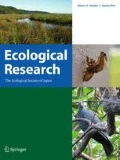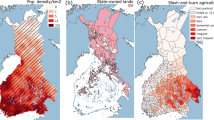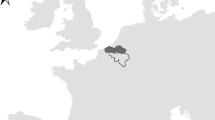Abstract
Particularly in the temperate climate zone many forests have, at some moment in their history, been used as agriculture land. Forest cover is therefore often not as stable as it might look. How forest plant communities recovered after agriculture was abandoned allows us to explore some universal questions on how dispersal and environment limit plant species abundance and distribution. All studies looking at the effects of historical land use rely on adequate land use reconstruction. A variety of tools from maps, archival studies, and interviews to field evidence and soil analyses contribute to that. They allow us to distinguish ancient from recent forests and many studies found pronounced differences in forest plant species composition between them. A considerable percentage of our forest flora is associated with ancient forests. These ancient forest plant species (AFS) all have a low colonization capacity, suggesting that dispersal in space (distance related) and time (seed bank related) limit their distribution and abundance. However recent forests generally are suitable for the recruitment of AFS. There is clear evidence that dispersal limitation is more important than recruitment limitation in the distribution of AFS. Dispersal in time, through persistent seed banks, does not play a significant role. Ancient forests are not necessary more species-rich than recent forest, but if diversity is limited to typical forest plant species then ancient forests do have the highest number of plant species, making them highly important for nature conservation. The use of molecular markers, integrated approaches and modelling are all part of the way forward in this field of historical ecology.







Similar content being viewed by others
References
Ash JE, Barkham JP (1976) Changes and variability in the field layer of a coppiced woodland in Norfolk, England. J Ecol 64:697-712
Bakker JP (1989) Nature management by grazing and cutting. Kluwer, Dordrecht
Bellemare J, Motzkin G, Foster DR (2002) Legacies of the agricultural past in the forested present: an assessment of historical land-use effects on rich mesic forests. J Biogeogr 29:1401–1420
Bierzychudek P (1982) Life histories and demography of shade-tolerant temperate forest herbs: a review. New Phytol 90:757–776
Bossuyt B, Hermy M (2001) Influence of land use history on seed banks in European temperate forest ecosystems: a review. Ecography 24:225–238
Bossuyt B, Deckers J, Hermy M (1999a) A field methodology for assessing man-made disturbance in forest soils developed in loess. Soil Use Manage 15:14–20
Bossuyt B, Hermy M, Deckers J (1999b) Migration of herbaceous plant species across ancient–recent forest ecotones in central Belgium. J Ecol 87:628–638
Bossuyt B, Heyn M, Hermy M (2002) Seed bank and vegetation composition of forest stands of varying age in central Belgium: consequences for regeneration of ancient forest vegetation. Plant Ecol 162:33–48
Brown A, Oosterhuis C (1981) The role of buried seeds in coppice woods. Biol Conser 21:19–38
Brunet J (1994) Der Einfluss von Waldnutzung und Waldgeschichte auf die Vegetation südschwedischer Laubwälder. Norddeutsche Naturschutzakademie-Berichte 3/94:96–101
Brunet J, Von Oheimb G (1998) Migration of vascular plants to secondary woodlands in southern Sweden. J Ecol 86:429–438
Buckley GP (ed) (1994) Ecology and management of coppice woodlands. Chapman & Hall, London
Burgess RL, Sharpe DM (eds) (1981) Forest island dynamics in man-dominated landscapes. Springer, Heidelberg
Butaye J, Jacquemyn H, Hermy M (2001) Differential colonization causing non-random forest plant community structure in a fragmented agricultural landscape. Ecography 24:369–380
Cain ML, Damman H (1997) Clonal growth and ramet performance in the woodland herb, Asarum canadense. J Ecol 85:883–897
Cain ML, Damman H, Muir A (1998) Seed dispersal and the Holocene migration of woodland herbs. Ecol Monogr 68:325–347
Cain ML, Milligan BG, Strand AE (2000) Long-distance seed dispersal in plant populations. Am J Bot 87:1217–1227
Compton JE, Boone RD (2000) Long-term impacts of agriculture on soil carbon and nitrogren in New England forests. Ecology 81:2314–2330
De Keersmaeker L, Rogiers N, Lauriks R, De Vos B (2001) Ecosysteemvisie bos Vlaanderen, ruimtelijke uitwerking van de natuurlijke bostypes op basis van bodemgroeperingseenheden en historische boskaarten. Report VLINA C97/06, AMINAL, afd. Natuur.109p
Desender K, Ervynck A, Tack G (1999) Beetle diversity and historical ecology of woodlands in Flanders. Belg J Zool 129:139–156
Donohue K, Foster DR, Motzkin G (2000) Effects of the past and the present on species distribution: land-use history and demography of wintergreen. J Ecol 88:303–316
Dupouey JL, Dambrine E, Laffite JD, Moares C (2002) Irreversible impact of past land use on forest soils and biodiversity. Ecology 83:2978–2984
Dzwonko Z, Loster S (1992) Species richness and seed dispersal to secondary woods in southern Poland. J Biogeogr 19:195–204
Ehrlén J, Lethilä K (2002) How perennial are perennial plants? Oikos 98:308–322
Ehrlén J, Eriksson O (2000) Dispersal limitation and patch occupancy in forest herbs. Ecology 81:1667–1674
Ellenberg H (1978) Vegetation Mitteleuropas mit den Alpen, 2nd edn. Ulmer, Stuttgart
Endels P, Adriaens D, Verheyen K, Hermy M (2004) Population structure and adult performance of forest herbs in three contrasting habitats. Ecography 27:225–241
FAO (2001) Global Forest Resources Assessment 2000. Food and Agriculture Organization of the United Nations, Rome.http://www.fao.org/forestry/fo/fra/index.jsp
Flinn KM, Marks PL (2004) Land-use history and forest herb diversity in Tompkins County, New York, USA. In: Honnay O, Verheyen K, Bossuyt B, Hermy M (eds) Forest biodiversity: lessons from history for conservation. CABI, Wallingford, pp 81–95
Flinn KM, Vellend M (2005) Recovery of forest plant communities in post-agricultural landscapes. Front Ecol Environ 3:243–250
Flinn KM, Vellend M, Marks PL (2005) Environmental causes and consequences of forest clearance and agricultural abandonment in central New York. J Biogeogr 32:439–452
Foster DR (1992) Land-use history (1730–1990) and vegetation dynamics in central New England. J Ecol 80:753–772
Foster DR, Motzkin G, Slater B (1998) Land-use history as long-term broad-scale disturbance: regional forest dynamics in central New England. Ecosystems 1:96–119
Gebhardt VH (1982) Phosphatkartierung und bodenkundliche Geländeuntersuchungen zur Eingrenzung historischer Siedlungs- und Wirtschaftsflächen des Geestinsel Flögeln, Kreis Cuxhaven. Probleme Kustenforschung sudlichen Nordseegebeit 14:1–9
Graae BJ (2000) The effect of landscape fragmentation and forest continuity on forest floor species in two regions of Denmark. J Veg Sci 11:881–892
Graae BJ, Hansen T, Sunde PB (2004) The importance of recruitment limitation in forest plant species colonization: a seed sowing experiment. Flora 199:263–270
Grashof-Bokdam C (1997) Forest species in an agricultural landscape in the Netherlands: effects of habitat fragmentation. J Veg Sci 8:21–28
Grashof-Bokdam CJ, Geertsema W (1998) The effect of isolation and history on colonization patterns of plant species in secondary woodland. J Biogeogr 25:837–846
Grime JP (1979) Plant strategies & Vegetation processes. Wiley, Chichester
Hall B, Motzkin G, Foster DR (2002) Three hundred years of forest and land-use change in Massachusetts, USA. J Biogeogr 29:1319–1335
Härdtle W (1994) Zur Veränderung und Schutzfähigkeit historisch alter Wälder in Schleswig-Holstein. Norddeutsche Naturschutzakademie-Ber 3/94:88–96
Heinken T (2004) Migration of an annual myrmecochore: a four year experiment with Melampyrum pretense L. Plant Ecol 170:55–72
Hermy M (1985) Ecologie en fytosociologie van oude en jonge bossen in Binnen-Vlaanderen. PhD Thesis, State University Gent
Hermy M, Stieperaere H (1981) An indirect gradient analysis of the ecological relationships between ancient and recent riverine woodlands to the south of Bruges. Vegetation 44:46–49
Hermy M, Honnay O, Firbank L, Grashof-Bokdam C, Lawesson JE (1999) An ecological comparison between ancient and other forest plant species of Europe, and the implications for conservation. Biol Conserv 91:9–22
Higashi S, Tsuyuzaki S, Ohara M, Ito F (1989) Adaptive advantages of ant-dispersed seeds in the myrmecochorous plant Trillium tschonoskii (Liliaceae). Oikos 54:389–394
Higgins SI, Richardson DM (1999) Predicting plant migration rates in a changing world: the role of long-distance dispersal. Am Nat 153:464–475
Honnay O, Hermy M, Coppin P (1999) Impact of habitat quality on forest plant species colonization. Forest Ecol Manage 115:157–170
Honnay O, Verheyen K, Butaye J, Jacquemyn H, Bossuyt B, Hermy M (2002a) Possible effects of climate change and habitat fragmentation on the range of forest plant species. Ecol Lett 5:525–530
Honnay O, Bossuyt B, Verheyen K, Butaye J, Jacquemyn H, Hermy M (2002b) Ecological perspectives for the conservation of plant communities in European temperate forests. Biodivers Conserv 11:213–242
Honnay O, Jacquemyn H, Bossuyt B, Hermy M. (2005) Forest fragmentation effects on patch occupancy and population viability of herbaceous plant species. New Phytol 166:723–736
Inghe O, Tamm C-O (1985) Survival and flowering of perennial herbs. IV. The behaviour of Hepatica nobilis and Sanicula europaea on permanent plots during 1943–81. Oikos 45:400–420
Ito S, Nakayama R, Buckley GP (2004) Effects of previous land-use on plant species diversity in semi-natural and plantation forests in a warm-temperate region in southeastern Kyushu, Japan. Forest Ecol Manag 196:213–225
Jacquemyn H, Butaye J, Hermy M (2001) Forest plant species richness in small, fragmented mixed deciduous forest patches: the role of area, time and dispersal limitation. J Biogeogr 28:801–812
Jacquemyn H, Honnay O, Galbusera P, Roldan-Ruiz I (2004) Genetic structure of the forest herb Primula elatior in a changing landscape. Mol Ecol 13:211–219
Koerner W, Dupouey JL, Dambrine E, Benoît M (1997) Influence of past land use on the vegetation and soils of present day forest in the Vosges mountains, France. J Ecol 85:351–358
Lawesson JE, de Blust G, Grashof-Bokdam C, Firbank L, Honnay O, Hermy M., Hobitz P, Jensen LM (1998) Species diversity and area-relationships in Danish beech forests. Forest Ecol Manag 106:235–245
Mabry C, Ackerly D, Gerhardt F (2000) Landscape and species level distribution of morphological and life history traits in a temperate woodland flora. J Veg Sci 11:213–224
Marks PL, Gardescu S (2001) Inferring forest stand history from observational field evidence. In: Egan D, Howell EA (eds) The historical ecology handbook: a restorationist’s guide to reference ecosystems. Island Press, Washington
Matlack RG (1994) Plant species migration in a mixed-history forest landscape in eastern North America. Ecology 75:1491–1502
Matlack RG, Monde J (2004) Consequences of low mobility in spatially and temporally heterogeneous ecosystems. J Ecol 92:1025–1035
Motzkin G, Foster D, Allen A, Harrod J, Boone R (1996) Controlling site to evaluate history: vegetation patterns of a New England sand plain. Ecol Monogr 66:345–365
Ohara M, Higashi S (1987) Interference by ground beetles with the dispersal by ants of seeds of Trillium species (Liliaceae). J Ecol 75:1091–1098
Ohkawara K, Higashi S (1994) Relative importance of ballistic and ant dispersal in two diplochorous Viola species (Violaceae). Oecologia 100:1091–1098
Ohkawara K, Higashi S, Ohara M (1996) Effects of ants, ground beetles and the seed-fall patterns on myrmecochory of Erythronium japonicum Decne. (Liliaceae). Oecologia 106:500–506
Packham JR, Harding DJL (1982) Ecology of woodland processes. Arnold, London
Peterken GF (1974) A method for assessing woodland flora for conservation using indicator species. Biol Conserv 6:39–45
Peterken GF (1977) Habitat conservation priorities in British and European woodlands. Biol Conserv 11:223–236
Peterken GF (1981) Woodland conservation and management. Chapman and Hall, London
Peterken GF, Francis M (1999) Open spaces as habitats for vascular ground flora species in the woods of central Lincolnshire, UK. Biol Conserv 91:55–72
Peterken GF, Game M (1984) Historical factors affecting the number and distribution of vascular plant species in the woodlands of central Lincolnshire. J Ecol 72:155–182
Petersen PM (1994) Flora, vegetation, and soil in broadleaved ancient and planted woodland, and scrub on Røsnæs, Denmark. Nordic J Bot 14:693–709
Petersen PM, Philipp M (2001) Implantation of forest plants in a wood on former arable land: a ten year experiment. Flora 196:286–291
Provan DM (1971) Soil phosphate analysis as a tool in archaeology. Norw Arch Rev 4:37–50
Rackham O (1975) Hayley wood. Cambridge and Isle of Ely Naturalists’ Trust Ltd., Cambridge
Rackham O (1980) Ancient woodland, its history, vegetation and uses in England. Arnold, London
Singleton R, Gardescu S, Marks PL, Geber MA (2001) Forest herb colonization of post-agricultural forests in central New York, USA. J Ecol 89:325–338
Smith BE, Marks PL, Gardescu S (1993) Two hundred years of forest cover changes in Tompkins County, New York. B Torrey Bot Club 120:229–247
Smith WB, Miles PD, Vissage JS, Pugh SA (2004) Forest resources of the United States, 2002.General technical report NC-241, St.Paul, USDA Forest service, North Central Forest Exp station
Tack G, Van den Bremt P, Hermy M (1993) Bossen van Vlaanderen. Een historische ecologie. Davidfonds, Leuven
Takahaskhi K, Kamitani T (2004) Effect of dispersal capacity on forest plant migration at a landscape scale. J Ecol 92:778–785
Thompson K, Bakker JP, Bekker RM (1997) The soil seed banks of North West Europe: methodology, density and longevity. Cambridge university press, Cambridge
Vanwalleghem T, Verheyen K, Hermy M, Poesen J, Deckers S (2004) Legacies of Roman land-use in the present-day vegetation in Meerdaal forest (Belgium)? Belg J Bot 137:181–187
Vellend M (2003) Habitat loss inhibits recovery of plant diversity as forests regrow. Ecology 84:1158–1164
Vellend M (2004) Parallel effects of land-use history on species diversity and genetic diversity of forest herbs. Ecology 85:3043–3055
Vellend M (2005) Land-use history and plant performance in populations of Trillium grandiflorum. Biol Conserv 124:217–224
Vellend M, Myers JA, Gardescu S, Mark PL (2003) Dispersal of Trillium seeds by deer: implications for long-distance migration of forest herbs. Ecology 84:1067–1072
Vellend M, Verheyen K, Jacquemyn H, Kolb A, van Calster H, Peterken GF, Hermy M (2006) Extinction debt of forest plants persists for more than a century following habitat fragmentation. Ecology 87:542–548
Verheyen K, Hermy M (2004) Recruitment and growth of herb-layer species with different colonizing capacities in ancient and recent forest. J Veg Sci 15:125–134
Verheyen K, Bossuyt B, Hermy M, Tack G (1999) The land use history (1278–1990) of a mixed hardwood forest in western Belgium and its relationship with chemical soil characteristics. J Biogeogr 26:1115–1128
Verheyen K, Honnay O, Motzkin G, Hermy M, Foster D (2003a) Response of forest plant species to land-use change: a life-history based approach. J Ecol 91:563–577
Verheyen K, Guntenspergen G, Biesbrouck B, Hermy M (2003b) An integrated analysis of the effects of past land-use on forest plant species colonization at the landscape scale. J Ecol 91:731–742
Verheyen K, Vellend M, Van Calster H, Peterken G, Hermy M (2004) Metapopulation dynamics in changing landscapes: a new spatially realistic model for forest plants. Ecology 85:3302–3312
Whigham D (2004) Ecology of woodland herbs in temperate deciduous forests. Ann Rev Ecol Syst 35:583–621
Whitney GG (1994) From coastal wilderness to fruited plain: a history of environmental change in temperate North America from 1500 to the present. Cambridge University Press, Cambridge
Whitney GG, Foster DR (1988) Overstorey composition and age as determinants of the understorey flora of woods of Central New England. J Ecol 76:867–876
Wilson BR, Moffat AJ, Nortcliff S (1997) The nature of three ancient woodland soils in southern England. J Biogeogr 24:633–636
Wulf M (1994) Überblick zur Bedeutung des Alters von Lebensgemeinschaften, dargestellt am Beispiel “historisch alter Wälder”. Norddeutsche Naturschutzakademie-Ber 3/94:3–14
Wulf M (1997) Plant species as indicators of ancient woodland in northwestern Germany. J Veg Sci 8:635–642
Wulf M (2004) Plant species richness of afforestation with different former use and habitat continuity. Forest Ecol Manage 195:191–204
Zacharias D (1994) Bindung von Gefässpflanzen an Wälder alter Waldstandorte im nördlichen Harzvorland Niedersachsens - ein Beispiel für die Bedeutung des Alters von Biotopen für den Pflanzenartenschutz. Norddeutsche Naturschutzakademie-Berichte 3/94:76–88
Acknowledgments
The first author would like to thank prof. Tohru Nakashizuka of the Research Institute for Humanity and Nature (RHIN) for the kind invitation to the international symposium of RHIN on sustainability and biodiversity of forest ecosystems, October 18, 2005. Blackwell Publishing and the Ecological Society of America are acknowledged for permission to reproduce several figures or part of them.
Author information
Authors and Affiliations
Corresponding author
About this article
Cite this article
Hermy, M., Verheyen, K. Legacies of the past in the present-day forest biodiversity: a review of past land-use effects on forest plant species composition and diversity. Ecol Res 22, 361–371 (2007). https://doi.org/10.1007/s11284-007-0354-3
Received:
Accepted:
Published:
Issue Date:
DOI: https://doi.org/10.1007/s11284-007-0354-3




